Rissani – Gateway to Africa
In the last post from the October 2025 Adventures Abroad Quintessential Tour of Morocco our group transitioned from the Imperial cities of northwest Morocco to the edge of the Sahara Desert in the small city of Erfoud. Today we are going to venture to the nearby town of Rissani which is considered to be the Gateway to Africa. This seems kind of strange since we are already well inside the continent of Africa, so let’s join our Tuareg guide Ali and find out more.
The Tuaregs in Morocco

The Tuareg people are a legendary sub-group of the Berbers of North Africa and the Sahel. They have long had a reputation as fierce nomadic tribesmen that right up until the present day are engaged in sometimes armed conflicts in Niger, Mali and Burkina Faso. There are estimated to be less than 4 million Tuaregs in total and this map shows there present geographical locations. As you can see, it does not extend to Morocco, but that’s not the whole story.
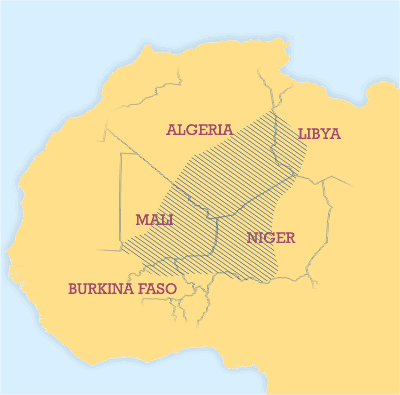
Although the origins of the Tuaregs is not completely clear, it is generally believed that they originated in the Tafilet oasis which just happens to be the largest in the world and which we are now smack in the middle of – in Morocco. Legend has it that a queen named Tin Hinan led a diaspora south from Tafilet in the 4th century spreading the Tuaregs throughout much of the western Sahara where the majority reside today. Apparently not many stayed behind in their ancestral homeland as there are less than 4,500 Tuaregs in Morocco today of which our guide for the day, Ali, is one.
Although he is dressed in the traditional Tuareg manner which includes the deep blue cloth for which his people are known, he is in fact university educated and very much a modern Moroccan. So let’s join Ali to find out more about Rissani and the Tafilet oasis.
History of Rissani
The history of Rissani really starts in the 8th century with a completely different name – Sijilmasa. This was a Berber founded settlement in the Tafilet oasis that quickly grew to be one of the most important stops on the trans-Saharan caravan routes. It was from here that the caravans headed off into the vastness of the desert for the salt mining centre of Taghaza some 850 kms. (530 miles) away in modern Mali. The great Muslim traveller Ibn Battuta took this route in 1352 and from Taghaza proceeded to the legendary city of Timbuktu which was at the southern end of the Sahara and the ultimate destination for south bound caravans. So the idea of Sijilmassa being the Gateway to Africa starts to make a lot of sense.

This is a map that shows that Sijilmassa, at its height, was a separate entity from the rest of Morocco that lasted until 1055 when the Almoravids captured it. They remained in control until succeeded by the Almohads in 1146 who massacred the large Jewish population. As we know by now, the Marinids took over from the Almohads and it was under their reign that Sijilmassa reached the height of its prosperity. When Ibn Battuta visited in 1352 he described it as a large and beautiful city, notable for its orchards and dates. And then the wheels came off, for reasons that are not readily apparent. When Leo Africanus arrived in 1500’s he found that the city was largely destroyed. Attempts to revive it the 18th century by Moulay Ismail were only temporary and in 1818 the place was finished off for good by the Ait Atta Berbers who claim descent from Goliath. But why did Moulay Ismail try to rebuild Sijilmassa?
After the decline of Sijilmassa, the town of Rissani was founded nearby and in places atop the ruins of the older city which was much larger in size than the present town in both area and population. Rissani became the place from which the entire Tafilet oasis was controlled and in the 17th century a family of Arabs, claiming direct descent from Mohammed, the Alawis, used it as the base from which they went on to conquer all of Morocco which they still rule to this day. So Sijilmassa is a big deal to the Alawis and they are hoping to turn it into a major archaeological site, but from what I can see on the ground, that will be a tall undertaking.
On our first stop Ali points what’s left of Sijilmassa and it ain’t much. Having been built mostly of mud and straw all I can see are the remnants of a few walls and nothing that you could identify as an actual building. I couldn’t even find a vantage point to get a good photo.
Nearby is the modern City Gate of Rissani aka The Gateway to Africa which dates only from 1968, but is faithful to the traditional Arab architecture it emulates.

Our next stop in Rissani is the mausoleum of Moulay Ali Sherif the founder of the Alawite dynasty.

Although non-Muslims are not permitted inside the mausoleum, we are allowed to look inside the mosque, but as in Fes, not go any further. The symmetry is truly amazing.
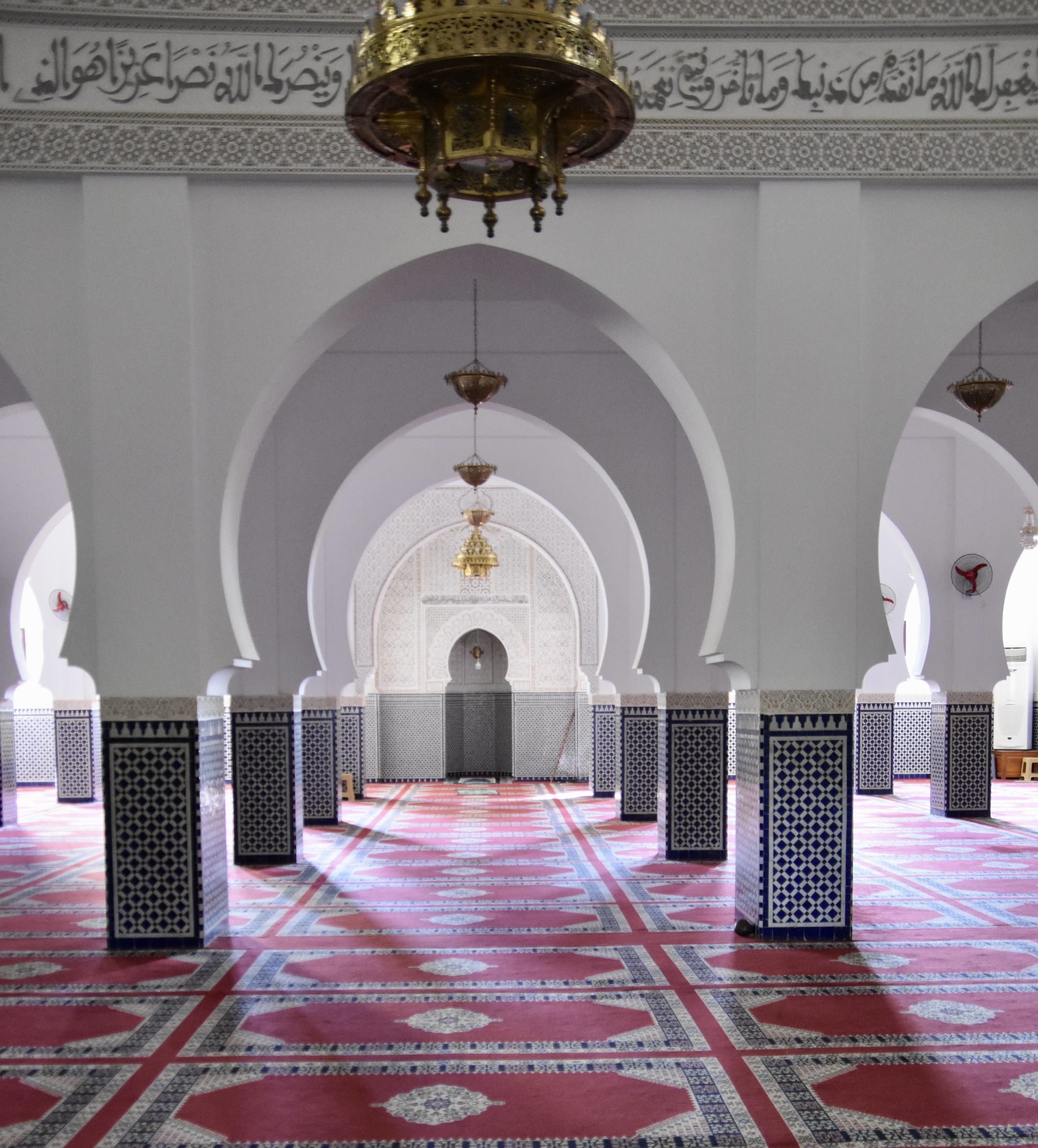
There is also an inner courtyard with a fountain and much greenery, not dissimilar to many of the cloisters I have visited in Christian abbeys and monasteries. It is a place devoid of other tourists and an oasis of quietude compared to the medinas we have visited. It makes a nice contrast.

It is also a good spot to observe a female date palm that is ripe with fruit. The great majority of palm species are monoecious, which means they have both male and female flowers, but date palms are either male or female. A number of our guides have pointed out the difference which is readily apparent once you know what to look for.

While I’m personally not a great fan of dates (I think date squares are abominable), the date palm is considered the ‘tree of life’ in Morocco, providing not only food and building material, but also acting as currency in the past. Rissani wouldn’t exist without dates. The Tafilet oasis is the home of the medjool date which is considered the finest in the world. It is larger and sweeter than ordinary dates with a caramel like flavour that earned it the title, ‘fruit of kings’. They are actually really good – if my mother had used these for her date squares I might have become a convert.
Seriously though, one of the things you have to try in Rissani are the medjool dates.
Dates are not the only comestible produced in the Tafilet oasis as we find out as we make our next stop in Rissani at the souk which is relatively tame compared to the ones in larger centres.
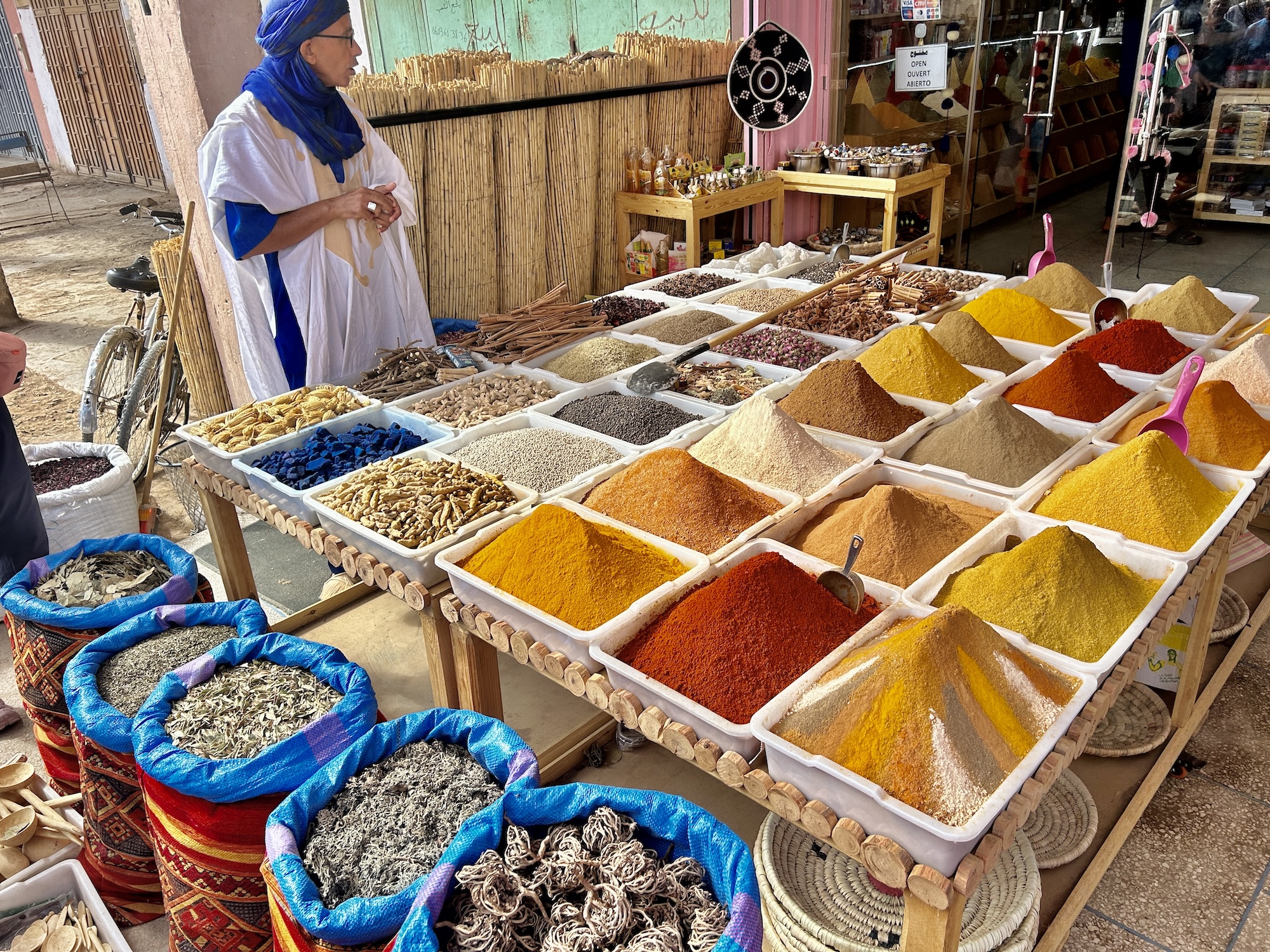
Is there anything more photogenic than a well laid out spice shop? We are all handed samples of the locally grown oasis marjoram, saffron, cumin, coriander seeds and several spice blends and a number of purchases are made.
In addition to the spices this shop sells what looks like blue rocks, but are actually indigo cakes made from the indigo plants that grow in Morocco and from which the blue dye which the Tuaregs use not only on their clothes, but also their hair and skin as well. If you do an internet search you’ll find Moroccan nila, which is just the powdered form of these cakes, touted as a wonder cure for almost everything from arthritis to aging.
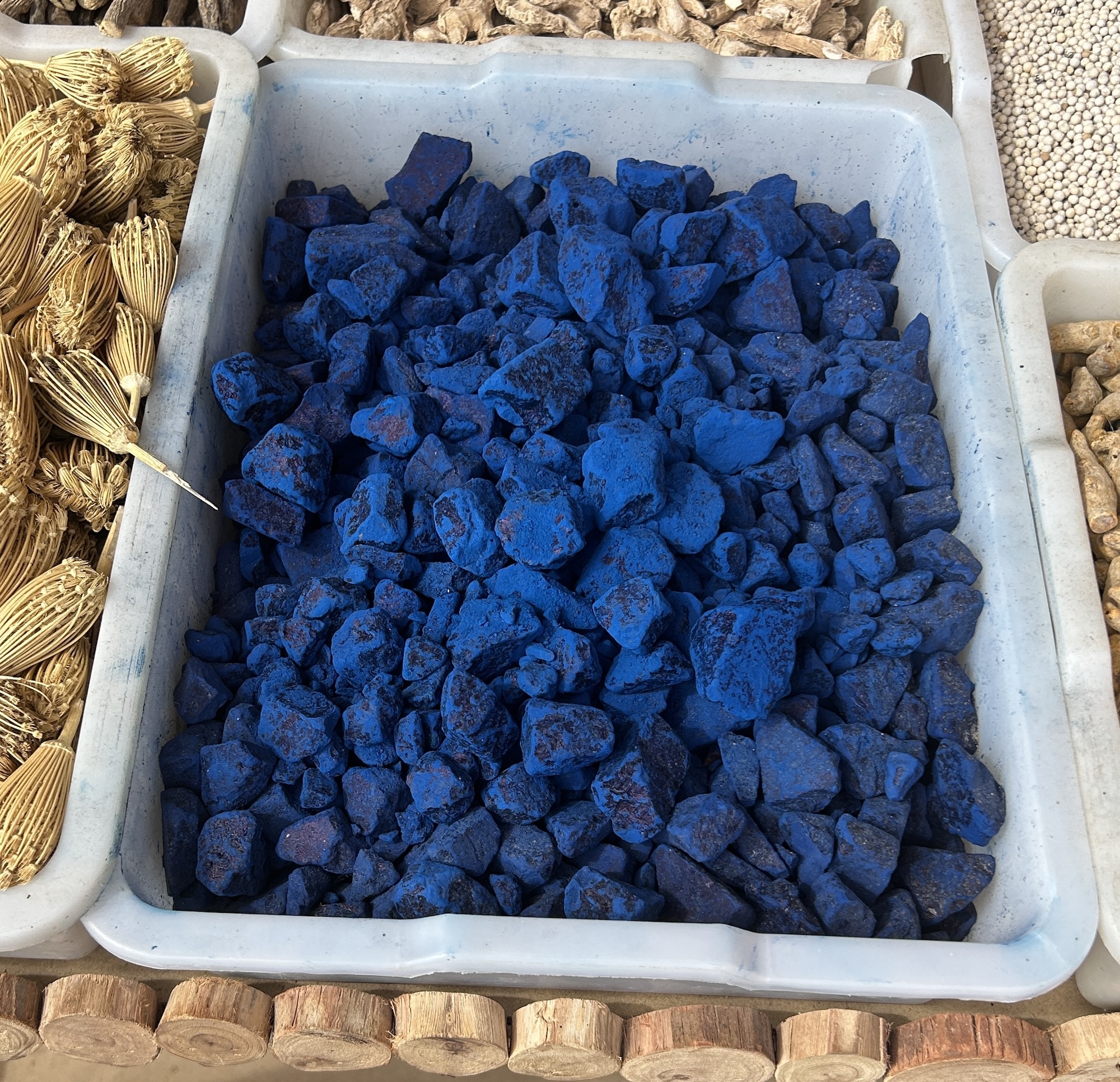
Ali next led us to the outside of this group of buildings which he explained was a ksar, a self-contained walled village with only one entrance. These were built as defensive positions against the nomadic raiders, often Tuaregs ironically, that right up until the 20th century were a real menace to settled Saharan communities. Unlike kasbahs, which were the strongholds of a single family or clan, ksars are still the homes of many families. Every ksar has a source of drinking water, a mosque and a school. Checking out a Google map of Rissani you’ll find numerous ksars in the area.
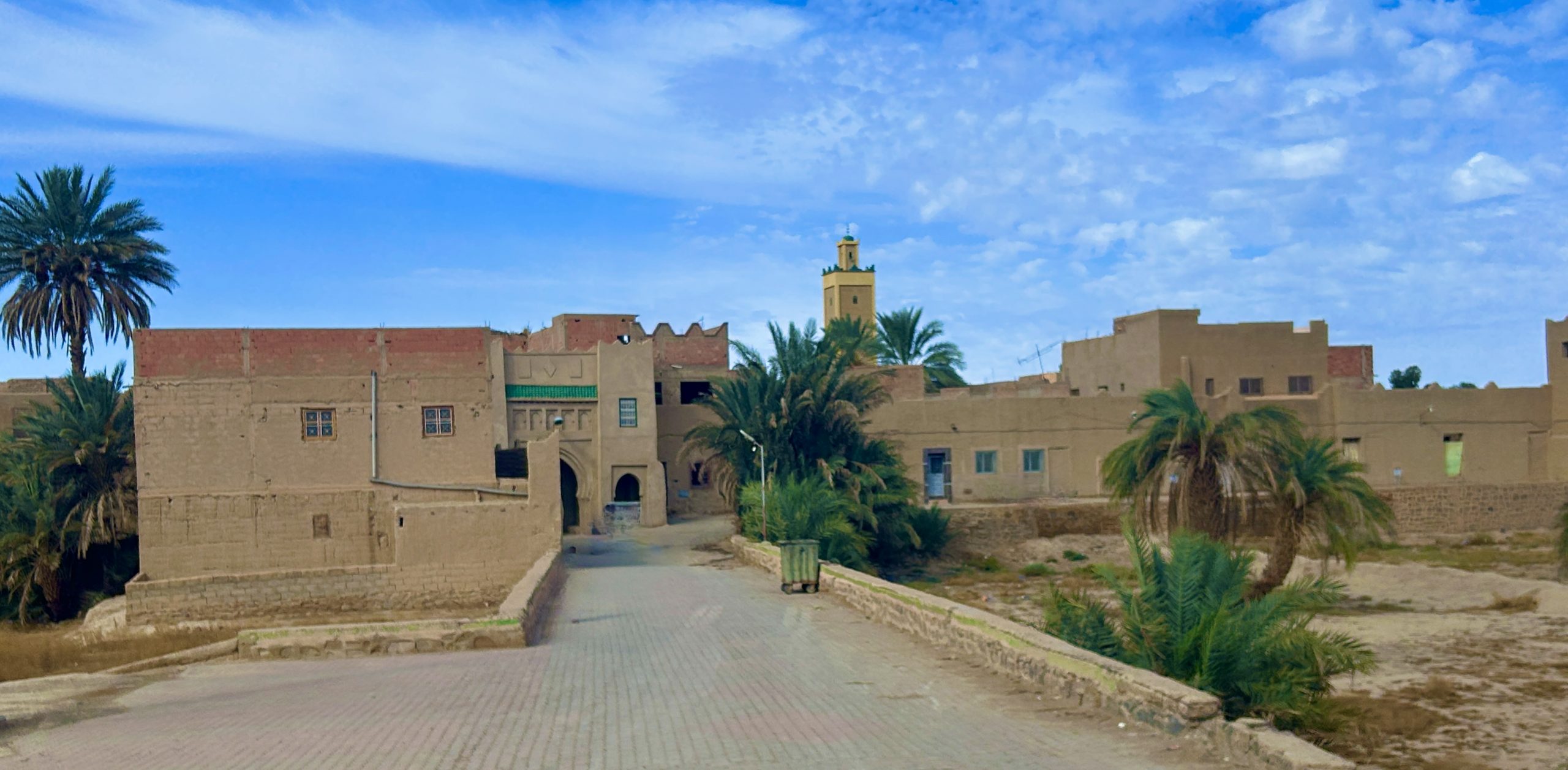
Inside the ksar there is no room for cars and it is distinctly quiet with seemingly no one around.

There are doors to residences, but as we have already learned from riads, no exterior windows. Many of the doors have symbols on them like these eyes that are intended to ward off evil spirits.
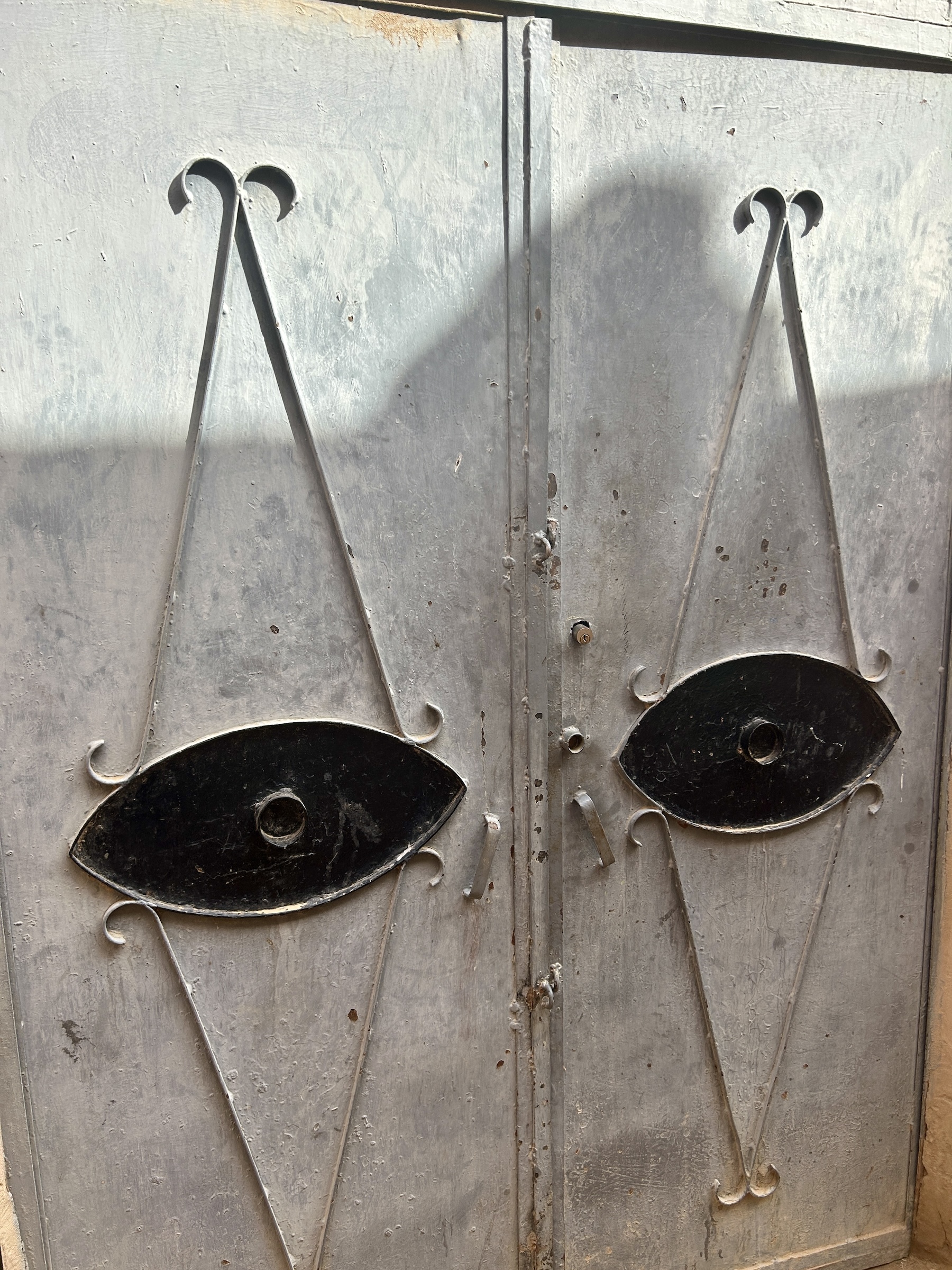
Although it might seem that the place is creepy, it’s actually not. After making a quick call, Ali leads us into the ksar’s one room school where there are about 30 children from ages 3 to around 10. It’s pretty apparent that they are just as amazed to see us as we are to see them in this very different scholastic environment. But children around the world are really much the same. No matter what their apparent circumstances, they are still innocent enough to be happy. Alison and I have observed this in previous AA trips in Egypt, Laos, Latin America and elsewhere. However, I don’t want to leave the impression that these kids are in any way under nourished or otherwise deprived. They’re not. They are well dressed, well behaved and as I say, happy to see us.
After the excitement of seeing this group of aliens appearing out of nowhere dies down, the teacher gets them to sing the Moroccan national anthem which they do with great enthusiasm. On our departure Laura makes a monetary gift on our behalf to help with school supplies.
While many people took pictures of the children, Ali asked that we not publish them on social media or elsewhere, so unlike some of my other posts from visits like this, there are no photos.
Moving on from the ksar, we made a brief stop to watch a camel being milked. Yes, you read that right, it was a camel milking. Apparently camel milk is very nutritious and nomads can live up to a month drinking nothing but it. It can also be used to make yogurt and ice cream, but not so readily cheese or butter due to its low coagulation rate.

Although, at Ali’s suggestion we all take a pass on trying the camel milk, that doesn’t preclude a cuddle with a camel calf.
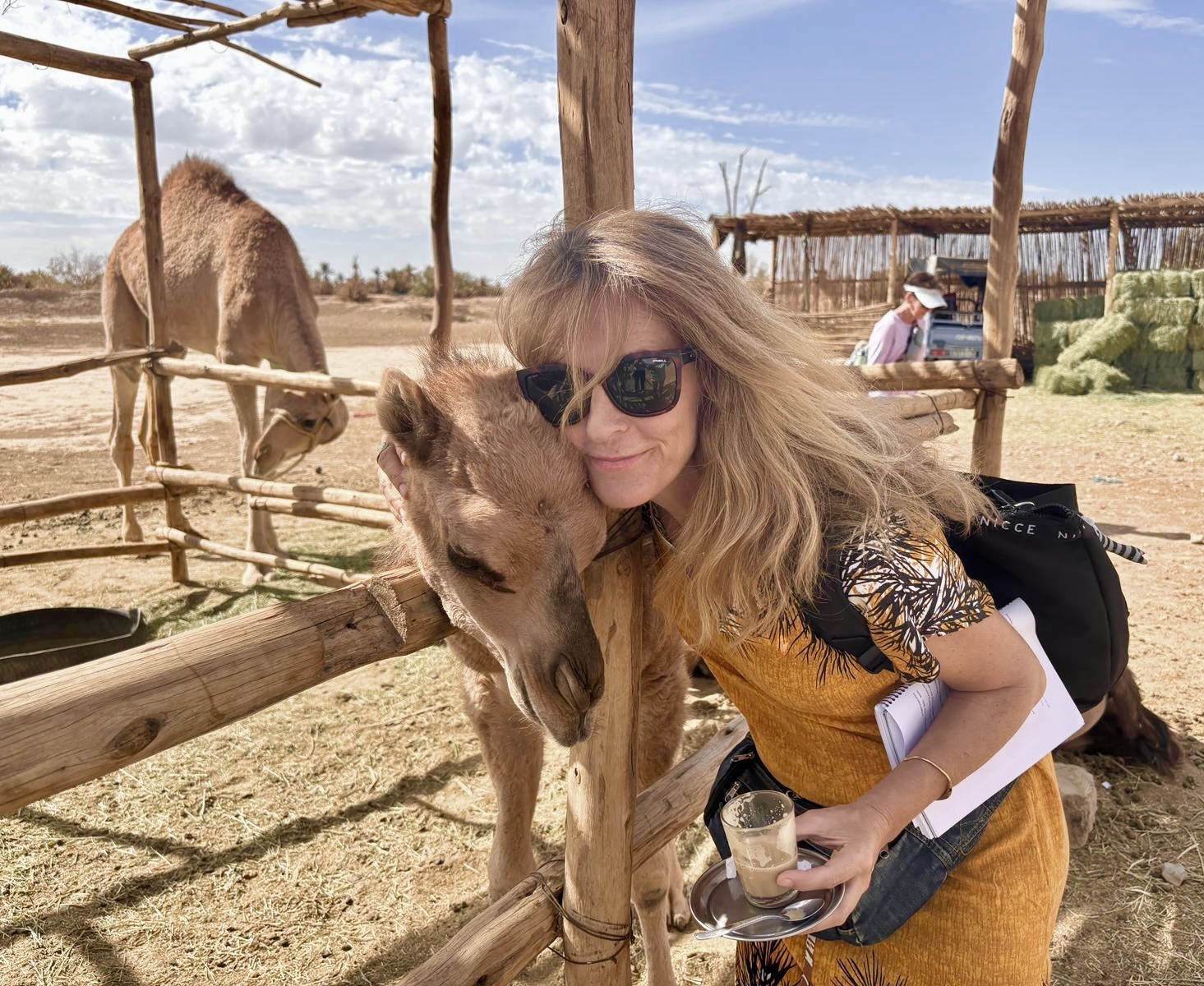
Aside from medjool dates, the Tafilet oasis is also world famous for its fossils and our final stop on this post will be at one of the many fossil shops in Rissani.
400 million years ago this is what Earth looked like – there were three large continents, Gondwana, Laurussia and Siberia and a few smaller islands. Everything else was one vast ocean. Morocco was then a marine shelf on the northwest corner of Gondwana, which is the large land mass at the bottom of the globe. This created the perfect conditions for the creation of fossils. In what is known as the Devonian Period the shallow seas were teeming with creatures that seem more like they belonged on a Stars Wars set than anything that lived on Earth. And then for reasons still unknown there was a mass extinction that took place over millions of years and completely wiped out the trilobites, a huge family of over 22,000 species that had existed for 270 million years.

As the trilobites and many other types of Devonian creatures died and sank to the silty bottom they were covered in mud and fossilized. There are literally untold numbers of these fossils in Morocco and over 40,000 people make their living extracting and selling them. Long before this trip was planned I was well aware of Morocco as one of the best places in the world to obtain quality fossils at prices a fraction of what they would be back home.
So I was pretty psyched about getting to see the Moroccan fossil shops and I can’t say I was disappointed. The fossils were magnificent.

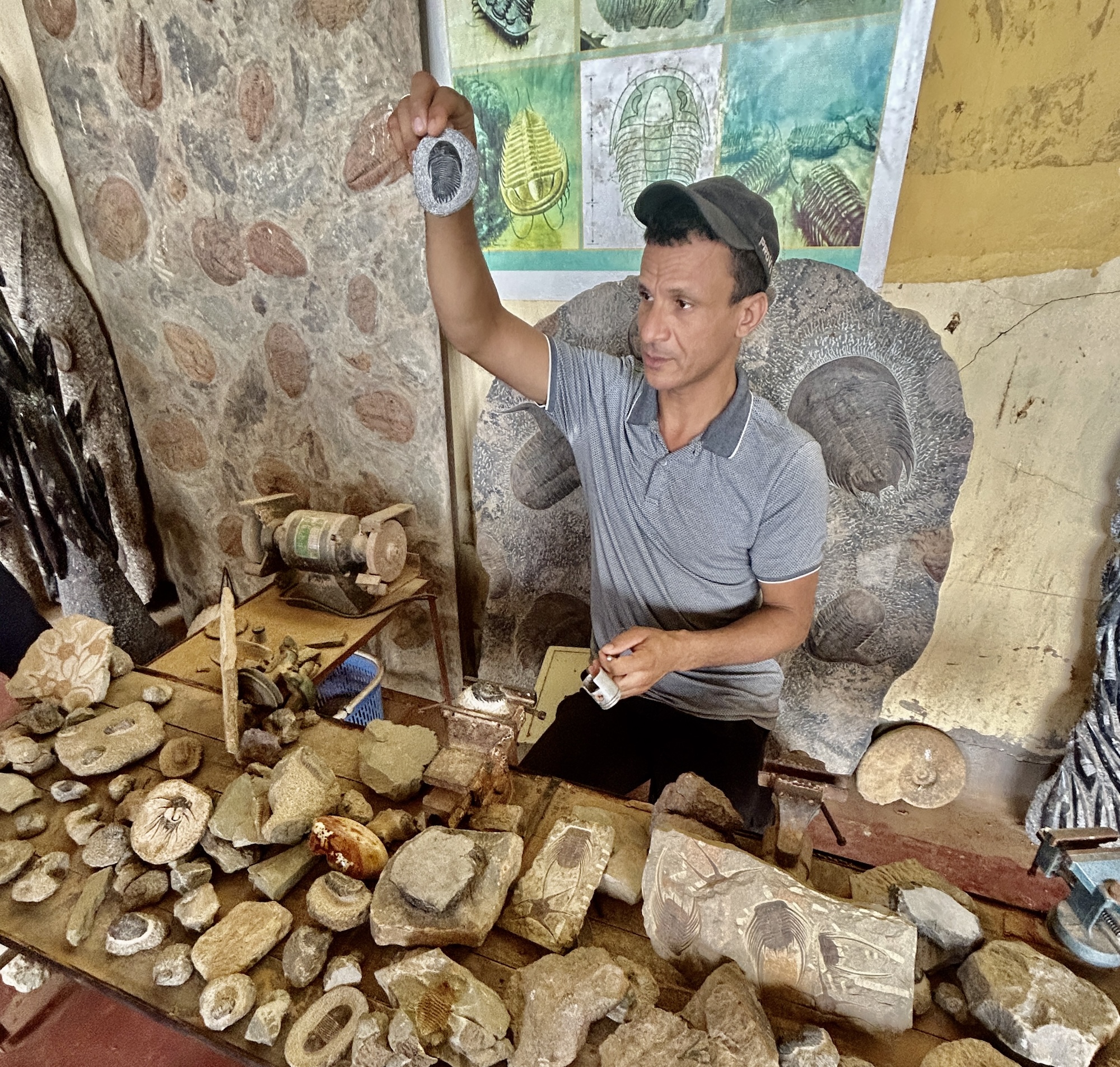
Now I did do my homework and ascertained that it was perfectly legal to buy Moroccan fossils and take them back home. As I said, there are literally millions of them in Morocco and their extraction and sale is sanctioned by the government. It is an important source of revenue for the country.
So here is my own personal trilobite. It’s hard to get my head around the fact that he/she/it is over 300 million years old.

So Alison got here Damascene dove at Meknes and I now have my personal keepsake from Morocco. It will become a family heirloom (I hope).
Well that’s it from Rissani. In the next post we’ll head directly into the Sahara to watch the sun go down from the top of a sand dune. Hope you’ll join us.

